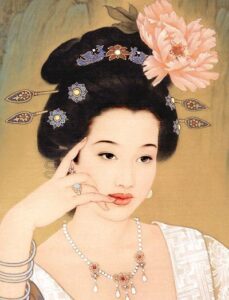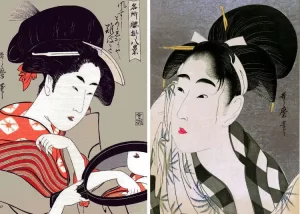Greetings, timeless beauties of the modern age! Are you ready to uncover the beauty secrets of the ancients? Today, we’re stepping into a time machine, whisking us back to the vanity tables of history’s most glamorous epochs. From the olive groves of Greece to the mystic temples of India, from Rome’s grand bathhouses to the delicate charm of the Far East, we’ll explore the beauty practices that have stood the test of time. Let’s glean wisdom from our ancestors and see how we can weave these age-old rituals into our contemporary beauty regime. Buckle up, beauties, we’re going on a historical ride!
Greece: Olive Oil, Honey, and Sea Salt
Ancient Greece, with its radiant gods and goddesses, knew a thing or two about beauty. Olive oil was the key to their glowing complexions, acting as a natural moisturizer, while honey served as a face mask for its antibacterial and hydrating properties. Sea salt was used as an exfoliator, sloughing off dead skin to reveal a fresh, vibrant glow.
 Today, we can incorporate these natural ingredients into our skincare routine. Try an olive oil and sea salt scrub, or a honey mask, to experience the Grecian glow!
Today, we can incorporate these natural ingredients into our skincare routine. Try an olive oil and sea salt scrub, or a honey mask, to experience the Grecian glow!
Rome: Wine Baths and Kohl Eyeliner
The Romans were lavish in their beauty rituals. They indulged in wine baths, as wine’s antioxidant properties were believed to promote youthful skin. It is very clear that they stole from ancient Egypt, but Romans too love to use kohl for their iconic, heavily lined eyes.

While we may not fill our tubs with Merlot today, we can use products with grape seed extract or resveratrol, which carry the same antioxidant benefits. Kohl eyeliner, on the other hand, has transcended time and is still a staple in our makeup bags.
Egypt: Milk and Honey Baths and Red Ochre
Cleopatra, the epitome of beauty in ancient Egypt, was known for her milk and honey baths. The lactic acid in milk served as a gentle exfoliant, while honey moisturized and brightened the skin. Egyptians also used red ochre as a lip and cheek stain for a natural flush of color.

Incorporate a milk and honey bath into your self-care routine to enjoy Cleopatra‘s beauty secret. As for the red ochre, replace it with a natural tint for your lips and cheeks.
The ancient Egyptians may have been the world’s first beauticians. And they were experts not only in beauty secrets but also in fragrances. Such that the oldest known perfume in the world belongs to them. Read now The Kyphi: The Aromatic Elixir of the Nile.
India: Turmeric and Henna
In ancient India, turmeric was a cornerstone of beauty rituals, hailed for its antiseptic and anti-inflammatory properties. It was often mixed into a paste and used as a face mask to enhance the complexion and keep skin problems at bay. Henna, on the other hand, was used to adorn the body with beautiful, intricate designs and to add a rich, reddish hue to the hair.
Today, we see the influence of these traditions persist. Turmeric face masks have gained global popularity, lauded for their skin-enhancing benefits. Just mix a little turmeric powder with honey for a simple, DIY face mask. Henna, too, continues to be a popular choice for temporary body art and a natural alternative to chemical hair dyes. Whether you’re looking for a radiant complexion or a touch of artistic adornment, these ancient Indian beauty practices offer time-tested wisdom.
China: Rice Water and Pearl Powder
In ancient China, women used rice water to cleanse their faces, as it is rich in vitamins and can brighten and smoothen the skin. They also used pearl powder, made from crushed freshwater pearls, for its skin-brightening properties and to protect the skin from sun damage.

Today, you can make your rice water at home or find skincare products enriched with rice extracts. Pearl powder is still available and can be mixed into creams or masks for that luminous glow.
Japan: Nightingale Droppings and Sake Baths
Japanese Geishas had a unique approach to skincare. They used nightingale droppings, which contain enzymes that break down dead skin cells and cleanse the skin. As for sake baths, the high fermentation of sake helps to remove toxins and brighten the skin.

Modern skincare has adopted these unusual practices, and you can find sanitized nightingale-dropping facial treatments in high-end spas. If you’re up for a sake bath, remember to use it diluted, and enjoy the detoxifying properties of this ancient Japanese practice.
There you have it, beauty mavens! A grand tour of ancient beauty practices, from the familiar to the downright unusual. These timeless secrets from our ancestors remind us that nature offers a wealth of ingredients for our beauty rituals. And while we may not all be ready to adopt Geisha skincare in its entirety, it’s fascinating to see where today’s trends have their roots.
So, whether you’re slathering your face with a turmeric mask, soaking in a milk and honey bath, or braving a sake soak, remember: beauty is a ritual, a moment of self-love that transcends time and culture. Until our next beauty adventure, stay radiant, stay curious, and stay beautiful!

